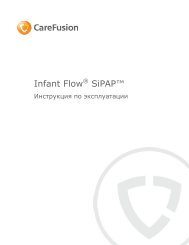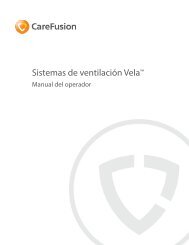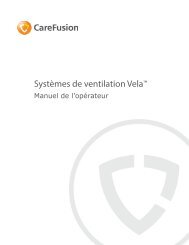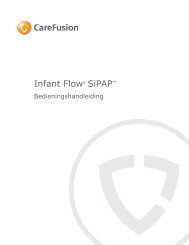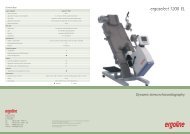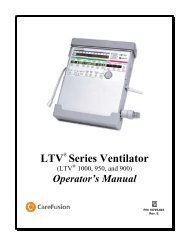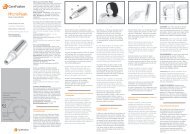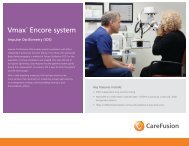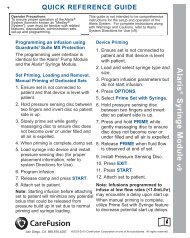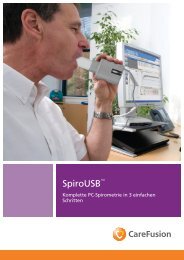3100B HFOV Operator Manual - CareFusion
3100B HFOV Operator Manual - CareFusion
3100B HFOV Operator Manual - CareFusion
Create successful ePaper yourself
Turn your PDF publications into a flip-book with our unique Google optimized e-Paper software.
<strong>3100B</strong> <strong>HFOV</strong> 1<br />
Chapter 1 Introduction<br />
Device Description<br />
This device is a high frequency oscillator ventilator. An earlier version of this device (the 3100A <strong>HFOV</strong>)<br />
has approval for treatment of respiratory failure in infants and children. This version of the device, the<br />
<strong>3100B</strong> <strong>HFOV</strong>, now has increased power capability and other modifications to allow treatment of adults.<br />
In a simplified description the patient circuit of the ventilator is a high-flow CPAP system. Oscillations<br />
are superimposed on the gas in the patient circuit using an electrically-driven diaphragm, similar to an<br />
audio loudspeaker cone. The oscillation frequency and magnitude can be varied. The frequency can<br />
be set between 3 and 15 cycles per second. The mean airway pressure can be set from approximately<br />
5 to 55 cmH2O and the bias flow (continuous sweep flow through the circuit) can be set from 0 to 60<br />
liters per minute. The maximum pressure swing is approximately 140 cmH2O measured at the patient<br />
circuit. Corresponding pressure swings in the trachea would be in the range of 10% of this value<br />
because of attenuation in the tracheal tube. The maximum tidal volume will be approximately 250 ml<br />
depending on the ventilator settings, tracheal tube size and the patient's pulmonary compliance.<br />
Typical settings are considerably less than these maximum values. The tidal volumes typically used are<br />
similar to the volume of the anatomic dead space. Various mechanisms have been described to explain<br />
how these small volumes cause effective gas exchange (summarized in Krishnan and Brower, 2000).<br />
The <strong>CareFusion</strong> 3100 B includes alarms for overpressure and low pressures that will detect certain<br />
problems such as circuit disconnects, and some partial obstructions. The air-oxygen blender, oxygen<br />
monitor, and humidifier are connected before the gas inlet to the patient circuit; these elements are<br />
conventional and are provided by the user.<br />
Indications for Use<br />
The <strong>CareFusion</strong> <strong>3100B</strong> is indicated for use in the ventilatory support and treatment of selected patients<br />
35 kilograms and greater with acute respiratory failure.<br />
Contraindications<br />
Warnings<br />
The <strong>CareFusion</strong> <strong>3100B</strong> Oscillatory Ventilator has no specific contraindications.<br />
The following Warnings must be read and understood before an attempt is made to operate the Model<br />
<strong>3100B</strong> <strong>HFOV</strong>:<br />
The Model <strong>3100B</strong> was not studied for use in children. Similar devices, <strong>CareFusion</strong> 3100 and<br />
3100A, are indicated for use in infant and children.<br />
Do not attempt to defeat the proper connection of the ground wire as it may cause damage to the<br />
device or interconnected equipment and could be injurious to the patient or to those<br />
associated with the device use. This device is factory equipped with a hospital-grade AC<br />
power plug. Grounding reliability can only be assured when connected to a tested receptacle<br />
labeled “Hospital Grade.”<br />
Do not operate radio transmitters within 20 feet of this instrument. This may result in erroneous<br />
pressure readings leading to false alarms and automatic shutdown.<br />
767164–101 Rev. R



